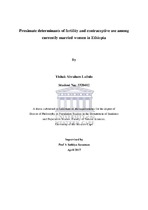| dc.description.abstract | Fertility is one of the elements in population dynamics that has significant contribution
towards changing population size and structure over time. In Ethiopia, fertility dropped only
slightly between 2000 and 2005, from 5.5 children per woman to 5.4, and then decreased
further to 4.8 children in 2011(CSA, 2012). Although a slight decreasing trend has shown
from year to year, it is still high as compared to developed nations (Tewodros,2011).
The age at which childbearing begins is an important factor in the overall level of fertility as
well as of the health and well-being of the mother and the child (CSA, 2012).In 2008, of the
1.4 billion women in the developing world of reproductive age (15-49 years), more than 570
women die per 100,000 live births, and 70 percent of them die due to totally avoidable
reasons (World Bank,2010). These women live in countries where their status is poor to
extremely poor, and these conditions threaten their health in many ways. Sedgh,
Hussain, Bankole, and Singh (2007) found that wherever fertility is high, maternal and
infant and child mortality rates are high. In addition to these, high fertility and shorter
birth intervals affect the survival chance of children and the health status of mothers.
Demographic and Health Surveys (DHS) data from 18 developing countries in Asia,
Latin America, Africa, and the Middle East showed that a birth interval of threeyears
increases the survival status of under-five children (Rutstein, 2003). Moreover, a similar
survey of 52 developing countries found that markedly short birth intervals have a negative
effect on pregnancy outcomes, increased morbidity in pregnancy, and increased infant
and child mortality (Rutstein,2005). Setty-Venugopal and Upadhyay (2002) have
documented that, in Sub-Saharan Africa, about 60% of women deliver the next child before
the index child celebrates his/her third birthday, and almost a quarter before the second
birth day. | |

